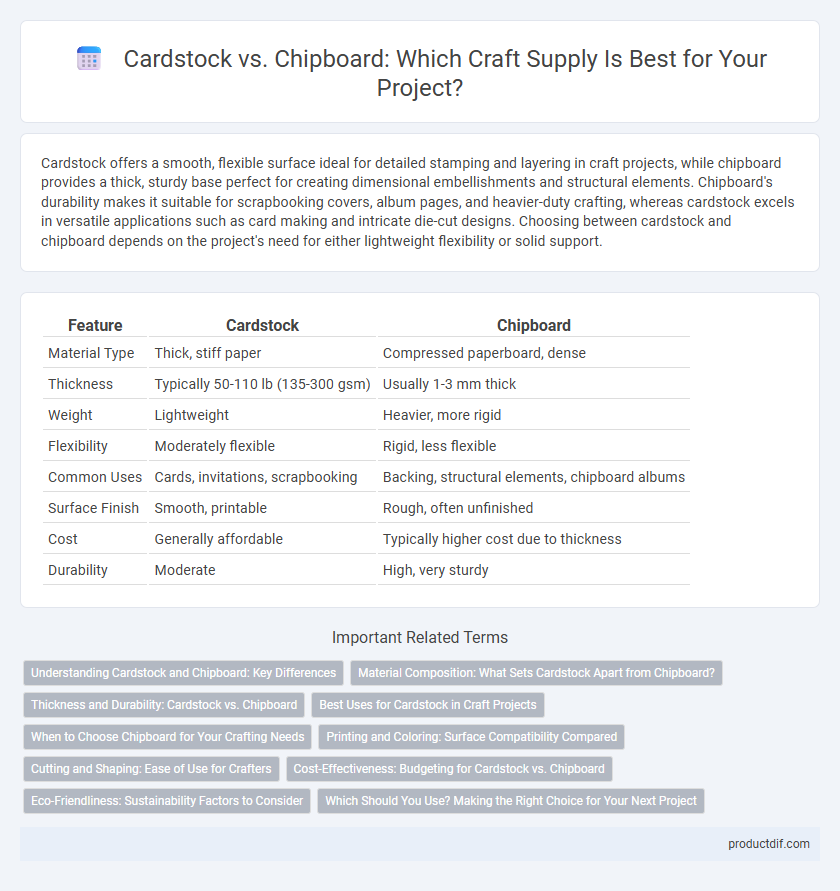Cardstock offers a smooth, flexible surface ideal for detailed stamping and layering in craft projects, while chipboard provides a thick, sturdy base perfect for creating dimensional embellishments and structural elements. Chipboard's durability makes it suitable for scrapbooking covers, album pages, and heavier-duty crafting, whereas cardstock excels in versatile applications such as card making and intricate die-cut designs. Choosing between cardstock and chipboard depends on the project's need for either lightweight flexibility or solid support.
Table of Comparison
| Feature | Cardstock | Chipboard |
|---|---|---|
| Material Type | Thick, stiff paper | Compressed paperboard, dense |
| Thickness | Typically 50-110 lb (135-300 gsm) | Usually 1-3 mm thick |
| Weight | Lightweight | Heavier, more rigid |
| Flexibility | Moderately flexible | Rigid, less flexible |
| Common Uses | Cards, invitations, scrapbooking | Backing, structural elements, chipboard albums |
| Surface Finish | Smooth, printable | Rough, often unfinished |
| Cost | Generally affordable | Typically higher cost due to thickness |
| Durability | Moderate | High, very sturdy |
Understanding Cardstock and Chipboard: Key Differences
Cardstock is a thick, durable paper commonly used for invitations, scrapbooking, and decorative projects, providing flexibility and ease of cutting. Chipboard is a dense, rigid material made from recycled paperboard, ideal for creating sturdy bases, boxes, and structural components in crafts. Understanding these differences helps crafters choose the right material based on project durability and design needs.
Material Composition: What Sets Cardstock Apart from Chipboard?
Cardstock consists of thick, durable paper often made from cotton or wood pulp, offering flexibility and smoothness ideal for detailed crafting and printing. Chipboard is composed of recycled cardboard layers compressed together, creating a rigid, dense material suited for structural projects and heavy-duty applications. The primary distinction lies in cardstock's pliability and fine texture versus chipboard's sturdiness and rigidity, influencing their specific uses in craft supply projects.
Thickness and Durability: Cardstock vs. Chipboard
Cardstock typically ranges from 65 to 110 lb in weight, offering moderate thickness and flexibility ideal for detailed crafting projects. Chipboard, made from pressed paper pulp, is significantly thicker and more rigid, providing enhanced durability and structure for scrapbooking, box making, and heavy-duty crafts. The superior thickness of chipboard makes it better suited for projects requiring long-lasting support and a sturdy base compared to the lighter, more versatile cardstock.
Best Uses for Cardstock in Craft Projects
Cardstock offers versatility for detailed craft projects due to its smooth texture and flexibility, making it ideal for intricate die-cut shapes, scrapbooking embellishments, and handmade cards. It supports various mediums such as ink, paint, and adhesives without warping, ensuring clean and precise results. Lightweight yet sturdy, cardstock is perfect for layering techniques and creating dimensional paper crafts that require easy folding and cutting.
When to Choose Chipboard for Your Crafting Needs
Choose chipboard for crafting projects that require sturdy, durable backing, such as scrapbooking or structural elements in boxes and frames. Its thick, rigid composition supports weight and holds up well to layering, painting, and gluing without warping. Compared to cardstock, chipboard is ideal when strength and longevity are essential for the finished piece.
Printing and Coloring: Surface Compatibility Compared
Cardstock offers a smooth, coated surface ideal for vibrant ink printing and detailed coloring techniques, ensuring crisp images and consistent color absorption. Chipboard's rougher, porous texture absorbs inks unevenly, making it less suitable for fine printing but excellent for layering and mixed media projects. For precise color work and high-resolution prints, cardstock provides superior surface compatibility compared to the more textured, absorbent chipboard.
Cutting and Shaping: Ease of Use for Crafters
Cardstock offers smooth cutting and easy shaping with most standard craft knives and scissors, making it ideal for detailed designs and intricate projects. Chipboard, being thicker and denser, requires heavier-duty tools such as craft knives or die-cutting machines to achieve clean cuts and precise shapes. While cardstock provides flexibility and ease, chipboard delivers durability but demands more effort during cutting and shaping processes.
Cost-Effectiveness: Budgeting for Cardstock vs. Chipboard
Cardstock offers a more cost-effective option for crafting projects due to its lower price per sheet compared to chipboard, making it ideal for budget-conscious hobbyists. Chipboard, while more expensive, provides greater durability and structural support, justifying its higher cost for projects requiring sturdiness and longevity. Evaluating project requirements and volume needs helps crafters balance cost with material performance to maximize value in their supplies budget.
Eco-Friendliness: Sustainability Factors to Consider
Cardstock, made from compressed paper fibers, is generally more eco-friendly due to higher recyclability and lower production energy compared to chipboard, which often contains glued layers and coatings that hinder recycling. Chipboard, typically sourced from recycled paper, supports sustainability by repurposing waste materials but may involve adhesives or finishes that reduce biodegradability. When choosing between cardstock and chipboard, consider the lifecycle impact, including recyclability, production emissions, and potential for reuse within crafting projects.
Which Should You Use? Making the Right Choice for Your Next Project
Cardstock offers flexibility and smoothness ideal for detailed stamping and layering, while chipboard provides sturdy support perfect for scrapbooking and dimensional projects. Choosing cardstock is best for lightweight, intricate designs requiring easy folding, whereas chipboard excels in creating durable bases and three-dimensional elements. Assessing your project's need for strength versus delicacy ensures the right material enhances both functionality and aesthetic appeal.
Cardstock vs Chipboard Infographic

 productdif.com
productdif.com